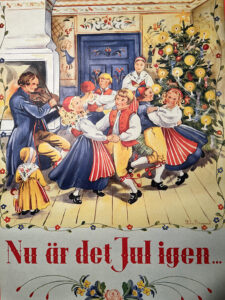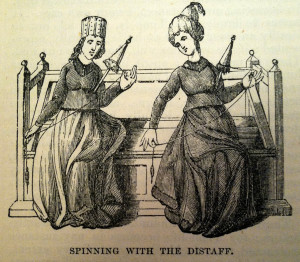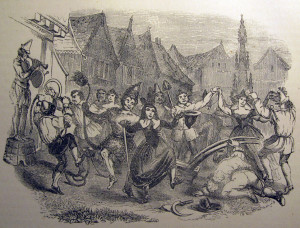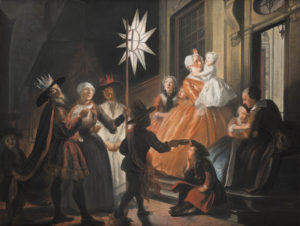In Sweden, the Christmas season began last month with Sankta Lucia’s Day on the 13th of December, and now, one month later, on this 13th of January, comes St. Knut’s Day: it is the day there when Christmas ends. And it ends with a plundering: All the cookies and candies that decorated the tree get eaten up! The Swedes like to dance around their Christmas trees with simple arm-linked rounds and skips, and this, too, will happen today, as it did on Christmas Eve… and then, finally, the tree is taken down (and sometimes tossed out the window).
I love things like this… and this, no doubt, is because I am a follower of rules. I stop at every stop sign I encounter on the road, I do every single push-up and jumping jack I’m told to do by my trainer, I do not cut corners. In Sweden, we know: Christmas begins now! (Sankta Lucia says so.) Christmas now is done! (Sankt Knut says so.) Organized rules! How grand is that?
Here in the States, we have no clear rules for these things. There was a time not all that long ago––in my grandparents’ day, when my mom was a kid––when folks got their Christmas trees on or near Christmas Eve and it was considered bad luck to remove Christmas decorations before Epiphany. But no one cares about luck these days and the rules have all been tossed out the window (along with the tree, perhaps). And though outwardly I am not a terribly organized person––my boss stepped into my office doorway earlier this week and, with widened eyes, said, “Whoa, I thought my office was messy”)––I do, in fact, love order. As Björk sings in one of her songs (a song called “Hunter”): I thought I could organize freedom. How Scandinavian of me. I like knowing the rules and that’s probably my incentive in writing this Book of Days. I like knowing what’s expected of me each day.
And so while we here in the States never know, once Christmas Day has passed, when we might see a Christmas tree tossed curbside, it seems that in Sweden everyone knows that the tree comes down on St. Knut’s Day, for it, apparently, has always been thus. And how wonderful, too, that it’s done in a celebratory way: plundering the tree, smashing the gingerbread houses, gobbling up every last cookie and cake, and dancing rounds ’round the tree to songs with lines like Tjugondag Knut dansas julen ut och då plundras och kasseras granen!: “The 20th of Knut dances Christmas away and then the tree is plundered and thrown away!”
So we are, according to the Swedes, at the 20th Day of Christmas. Just enough days to count on all our fingers and toes. And certainly now a bit of clarity from this rule-follower is in order: Several weeks ago I told you there are two ways of counting the Twelve Days of Christmas and that the version I like best holds six days in the old year and six days in the new. I stand by that system, for I love the symmetry as Christmastide spans the ages. It is mostly churches that count the days differently, with the First Day of Christmas being Christmas Day (giving us seven days in the old year and five in the new)… and this is how the Swedes reckon things, too. For Sinkt Knut’s Day is widely known as Tjugondag and that word Tjugondag means “twentieth day.”
Aside from the plundering and the dancing, there are some regions of Sweden where folks would open their doors to all the neighbors in an effort to rid the home of all leftover Christmas treats… and once that was accomplished, the woman of the house would, armed with her broom but all in good fun, run through the house, sweeping under sofas, tables, and chairs, and then shooing all the guests out with blows of her broom, shouting, “Out Knut! Now Christmas is over!”
Here’s another end-to-Christmas song for dancing ’round the tree and smashing the gingerbread houses on this Tjugondag; it’s called “Nu är Glada Julen Slut, Slut, Slut”:
Snart är glada julen slut, slut, slut.
Julegranen bäres ut, ut, ut.
Men till nästa år igen
kommer han vår gamle vän,
ty det har han lovat.
Or, in English:
Soon merry Christmas is over, over, over.
The Christmas tree is carried out, out, out.
But until next year again
comes he our old friend,
for he has promised.
And good old Father Christmas does promise just this. I love the directness of Swedish Christmas songs. The most famous of them is the song that’s in the image at the top of this post: “Nu är det Jul Igen”. But that’s for the start of Christmas, at Christmas Eve, when folks first dance around the tree. It’s a centuries-old nonsense song whose lyric translates to, Now it is Christmas again and it will be Christmas until Easter. No! That isn’t true, for in between comes Lent. And so it does. Lent will come, Easter will come, Midsommar will come and the sun will never set, and then it will be harvest time and it will grow dark and Sankta Lucia will come and then it will be Christmas again.
Our image for today is from a print I purchased two Christmases ago at our local Swedish Julmarknad, or Christmas Market, which comes each November or December (depending on the year) at the First United Methodist Church in Boca Raton, Florida. Convivio Bookworks has a pop-up shop at the Julmarknad each year. It’s always a delightful afternoon!
Did you know we sell some truly delightful Scandinavian specialty foods at our shop? Just last weekend, my sister made homemade riskrem, the wonderful traditional Norwegian rice pudding. To make it, she cooked our Scandinavian Porridge Rice in milk, then added freshly whipped cream, and served it with our Wild Swedish Lingonberries and Vanilla Powdered Sugar. I added cinnamon and cardamom to the leftover riskrem with some additional vanilla powdered sugar and it was truly sublime. Oh, I wish I had more right now! Our Löfbergs Coffee from Sweden is also so good. It’s our favorite coffee in this house. I like the medium roast, but there is also a dark roast. Each bag contains over a pound of ground coffee.



